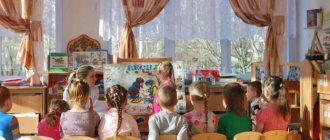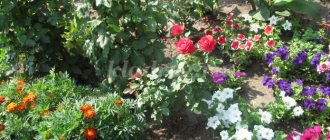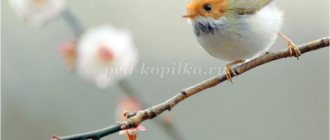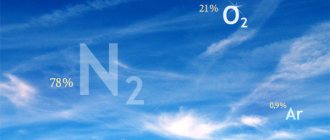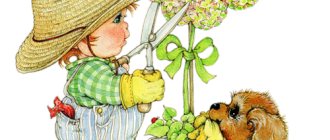The magical world of stones
What is the reason for the popularity of drawings on stones? The fact is that stone, unlike paper, concrete, plastic and other materials, lives for a very long time. It lives – the stone is born, formed and polished. It absorbs the energy of the sun, the power of the earth. Therefore, the creator, when choosing a stone for painting, is only an intermediary, a conductor, allowing the stone to come to life and convey its energy to the person who needs it.
A unique type of creativity - collecting, painting and decoupage of ordinary stones - was loved by the children and parents of our Cloudberry group, since it does not require any special expenses or skills, and the main material, stone, can be found literally under their feet.
One of the children brought smooth stones of different shapes and natural colors to the kindergarten, all the children began to look at them with enthusiasm, the stones interested them, captivated them, the children themselves included the stones in the plot of their game. During a walk in the kindergarten territory, the children began to collect the small pebbles they liked. The head of our kindergarten “Brusnichka”, Svetlana Sergeevna Dubovskaya, gave us the idea to start painting pebbles in different bright colors and to show creativity and imagination in making crafts. The children really liked the idea and enthusiastically began decorating the stone. By engaging in creative activities with unformed material, the child becomes involved in observing natural phenomena, becomes more familiar with the natural world, and improves his skills in caring for the environment. Due to climatic conditions, children of the North are moving further and further away from nature, forgetting its beauty and value. In order to reduce this gap, our kindergarten organizes excursions with children to the tundra in summer and autumn. I saw how children’s communication with nature turned into something exciting, surprising and delightful for children; communication with living and non-living nature made them think and sincerely rejoice. No book, no story can replace what children saw in the tundra with their own eyes and touched with their own hands. Their inner world was filled with new colors and impressions. It is at a young age that nature influences the child’s feelings with its brightness and diversity. Therefore, it is necessary to include practical creative activities for them to interact with nature. Another teacher Ushinsky wrote: “If you want to teach a child to think logically, introduce him to nature.”
Drawings on stones are an interesting technique for children. After all, such a painted pebble, unlike a paper picture, is not only a “work of art” of the young artist, but also a toy. Children are happy to paint the stones. The main thing is to take a closer look. After all, in every stone there is someone or something hiding: a cat, a car, a tree, a person... Each pebble appears to the child as a new friend. This means that they must have names, titles or purposes, like all surrounding objects. A painted pebble acquires its own shape, color, its own unique image; you can touch it, twist it, play with it. An ordinary stone “comes to life” and becomes a shaggy bear cub, a cheerful hedgehog, a fairy-tale craft, and the child involuntarily plunges into the world of fantasy and fairy tales, where his stones overcome difficulties, are sad, rejoice, and achieve success. Look carefully, and the pebbles will reveal their secret to you. And a brush and paints will help tell everyone else about it. In the course of joint creative work, Valeria turned a pebble into a colorful butterfly with paints, and especially for the butterfly she herself came up with a dance-game, where children turn into flowers, and the butterfly chooses a friend. The children enjoyed dancing with the stone, a butterfly, to the music. Some of the children wanted to draw their own butterfly, others a dragonfly. Thus, we have reached a new level beyond joint activities into independent activities.
Summary of educational activities “Amazing Stones” in the senior group
Educational areas: cognitive development (leading), speech development, social and communicative development, artistic and aesthetic development, physical development.
Goal: To familiarize students with the variety of stones, their properties and features.
Tasks:
Educational:
Introduce the main natural components and their connections;
Teach students to distinguish natural objects from artificial ones created by man, objects of living nature from objects of inanimate nature;
To develop the ability to examine and classify stones according to various criteria (color, shape, size, weight, temperature, buoyancy), to develop the ability to prove.
Educational:
Develop cognitive activity in the process of experimentation, visual and muscle memory;
encourage independent formulation of conclusions;
Strengthen the students’ ability to navigate the space of the playroom and on a sheet of paper;
Strengthen skills in working with magnifying devices;
Practice reading diagrams of the location of objects in a limited space, improve the ability to move in a given direction;
Develop interest and love for fairy tales;
To develop pupils’ speech in the process of conversation, the ability to use common sentences in speech; develop imagination, memory, attention.
Educational:
Cultivate interest in educational and research activities.
Main types of activities: cognitive-research, communicative, gaming, artistically productive, perception of fiction, motor.
Materials: chest of sensations, master's hat, sets of stones, lemon juice, pipette, wooden block, magnets, magnetic board, map of Russia; bathrobes, magnifying glasses, pieces of plasticine, glasses of water, spoons, trays and napkins for each child, gifts and surprises.
Vocabulary work : laboratory, magnifying glass.
Expected results:
distinguish natural objects from artificial ones created by man, objects of living nature from objects of inanimate nature; know how to read diagrams and navigate within a room; are able to identify the main features, properties and qualities when examining objects.
Progress:
Educator: Hello, guys! I am very happy about our meeting. Let's share our warmth and kindness with each other, let's hug tightly!
Educator: This morning I received an unusual letter. The sender's address is also mysterious - Mountain Country. Gnomes. But I was even more confused when I opened the envelope - there was not a single word in it, only incomprehensible diagrams. And you guys didn’t notice anything unusual in your garden. After all, I think it’s not for nothing that there is this sign on my message. Let's take a careful look around.
Orientation exercise on a sheet of paper
(Children find the box according to plan)
Educator: Which of you guys knows who the Dwarves are?
The children answer.
Educator: What are they doing?
The children answer.
Educator: gnomes live in real life or in a fairy tale. In which fairy tales are gnomes found? (Snow White and the 7 Dwarves. A Tale about a Dwarf. A Tale about a Dwarf and an Asterisk)
Tell me, which gnomes are good or evil? Listen to the work of the composer Grieg “Procession of the Dwarves” and determine by the nature of the music which gnomes they are.
Listening to “Procession of the Dwarves” by Grieg
Educator: you listened to the piece.
what is the nature of the music? (fast, fun, rhythmic)
Describe the gnomes, what are they like? (fun, fast, friendly...).
Educator: What do you think could be in the box?
Children's answers.
Educator: Now each of you will try to determine the contents of this box by touch.
Children: There are stones in the box.
Educator: tell me, do the stones belong to living or non-living nature? I suggest you remember what belongs to living and what to inanimate nature (living - humans, plants, animals; inanimate - stones, earth, clay, everything created by man)
Educator: Today our faithful assistants will be actively working. Eyes! Why do we need eyes?
Children: To watch.
Educator: Fingers?
Children: To touch, feel.
Educator: Ears?
Children: To listen.
Educator: The gnomes allowed us to look at their collection of stones, what are they? To do this, we are going to the laboratory. First, let's remember the rules of conduct in the laboratory.
The children answer.
Educator: We put on aprons and hats and go, make yourself comfortable.
Experiment No. 1. Determination of color, shape and size.
Children share observations about the color and shape of the stones.
Educator: Guys, show me your biggest stone. Now place all the stones in a row from largest to smallest.
Are all the stones the same size?
The children answer.
Educator: Conclusion: stones come in different colors, shapes and sizes.
Experiment No. 2. Determination of the nature of the surface.
Educator: Now we will need your sensitive fingers. Close your eyes, stroke your stones and try to select the most uneven, rough stone by touch. And now the smoothest pebble? Think about where you can most often find such a stone? (By the sea)
Children's answers.
Educator: Why do you think it doesn’t have sharp corners? (Water moves the stones, hits them against each other, they also rub against the sand, the sharp corners gradually wear off and disappear. The pebble becomes round.)
The children answer.
Educator: Conclusion: stones can be smooth and rough.
Experiment No. 3. Determination of hardness.
Educator: Take a pebble in one hand and a piece of plasticine in the other. Squeeze both palms together. What happened to plasticine?
Children's answers.
Educator: Why? What happened to the stone?
The children answer.
Educator: Why? Guys, do you think stone is harder than wood?
Children answer
Educator: Let's check. I'll take a hammer, a nail and a block of wood and try to drive the nail into the wood. What happened? (The nail went into the wood.)
The children answer.
Educator. Now I'll try to drive a nail into a stone. (He hammers it in - it doesn’t work. The nail bends, but doesn’t drive in.)
Educator: Well, was I able to hammer a nail into the stone?
The children answer.
Educator: What happened to the nail? How did the stone behave?
The children answer.
Educator: What conclusion can be drawn? Conclusion: The stone is hard and durable.
Experiment No. 4. Determination of temperature.
Educator: Guys, put your palms on the table and quickly on your cheeks. Do you feel the difference?
The children answer.
Educator: Our skin can quickly detect temperature. Now we will have a very difficult experience. You will need attention and concentration. Of all the stones, you need to choose the warmest and the coldest. How can I do that? (Press in palms, bring to cheek)
The children answer.
Educator: Conclusion: stones have different temperatures. How can you warm a cold stone?
The children answer.
Educator: I suggest you warm him up with your warm breath.
Breathing exercises
Children take the coldest stone and place it on their palms.
Take a deep breath through the nose, and exhale through the mouth, lips with a tube. (3 times)
Experiment No. 5. Buoyancy.
Educator: What happens if you put a pebble in water? (Children's versions)
The children answer.
Educator: How can you check this? Let's put our pebbles in a glass of water and watch it. What will happen to him?
(Children carefully place the stone in the water. Observe. The stone has sunk, air bubbles rise from it to the surface, the color has changed and become brighter.)
Educator: Guys, take out your stones and wipe them with a napkin. (Take the stone out of the water and wipe it with a napkin.)
Educator: Which stones do you like better, wet or dry?
The children answer.
Educator: Conclusion: stones sink in water because they are heavy.
Experiment No. 6. Stones make sounds.
Educator: Do you think stones can make sounds?
The children answer.
Educator: Knock them against each other. What do you hear?
The children answer.
Educator: These stones talk to each other and each of them has its own voice. Now, guys, I’ll drop some lemon juice on one of your pebbles. What's happening?
The children answer.
(The stone hisses, gets angry, doesn’t like lemon juice)
Educator: Conclusion: stones can make sounds.
Experiment No. 7. Examining stones through a magnifying glass.
Educator: What is the name of this device? (Magnifying glass.)
The children answer.
Educator: What is it for? (Enlarge image.)
The children answer.
Educator: Look at your palms. Now look at them through a magnifying glass? To better see the surface of the stones, we will do the same with them. (Look at stones through a magnifying glass)
Educator: What interesting things did you see?
The children answer.
Educator: Well done, you are very attentive! Now, guys, take your trays and let's lay out patterns of stones on the sand. Maybe at night, when the kindergarten is empty, the gnomes will return here again and will be very happy with such a gift, because gnomes love their stones very much. (Children go to another table, where large trays of sand have been prepared.)
Didactic game “Lay out the pattern”
Educator: look how beautiful the patterns turned out. I think the gnomes will really like it.
Now let's go to the palace.
Tell me how you liked working with the gnome stones. What did you like best?
MAGAZINE Preschooler.RF
Topic: “Amazing stones” Direction. Cognitive. Age: children 4 years old, middle group Integration of educational areas: “Cognition”, “Communication”, “Reading fiction”, “Artistic creativity”. Types of children's activities: play, cognitive-research, communicative, productive. Objectives: • To give an idea about stones and their properties. • Develop children's cognitive abilities and voluntary attention through experimental activities. • involve children in research activities to determine the characteristics and quality of stone (multi-colored, round, oval, sharp, smooth, rough, prickly, cold, warm, rattling, durable, strong, hard) and its benefits; • reinforce the safety rule (throwing stones is dangerous); • Teach children to independently draw conclusions based on the results of the experiment, relying on previously acquired ideas and their own assumptions. • Foster the desire to achieve good results; develop speech Planned results: Independently draw conclusions based on the results of the experiment, based on previously obtained ideas and your own assumptions. Methodological techniques: visual (use of pictures, didactic games); verbal (reminder, instructions, questions, individual answers from children); encouragement, lesson analysis Visual teaching aids. Cards for the games “Nature is not nature”, “Living - not living nature” hoops, Materials and equipment: a collection of stones, containers for experiments with water, multi-colored pebbles according to the number of children. Individual work. Develop attention and the ability to complete an experiment with Danil Sh, Leva Sh, Timur K. Vocabulary work: stones, clay, rough, wet. Structure 1. Conversation about nature, game “Nature is not nature” 2. Game “Living - not living nature” 3. Research laboratory. 4 Summary of the lessonGCD move. The teacher and children enter the group and stand in a circle on the carpet. Educator. Guys, look around, what surrounds us? (objects) And if you and I were in the forest, what would surround us? (trees, grass, flowers, insects) How can you call all this in one word? (nature) Look, on my cards there are drawn objects made by human hands and objects of nature - How can we distinguish what is nature and what is not? (in nature, everything grows, develops, and appears from another plant or animal, and things are made by man, and they no longer change themselves) We will put pictures of nature on the picture with a butterfly, and pictures of things made by man on the picture with a man. (children complete the task) Game “Nature is not nature” Guys, but nature is also different, Is grass nature? And the sun? Is the grass alive? Yes, that's right, alive, because it grows, breathes, gives seeds for new herbs. Is the sun alive? No, this is a hot star. This means that nature can be living and non-living. Let's arrange pictures with nature - put pictures with living nature in the green hoop, and pictures with inanimate nature in the yellow hoop. Game “Living and Inanimate Nature” Correct, are stones living or non-living nature? They don’t grow or move, which means they are inanimate nature. In what places are there a lot of stones? (in the sea, in the river, in the mountains)
-We will go to the laboratory again today. Let's remember what rules must be followed in the laboratory? (work carefully, take your time, don’t interfere with each other) That’s right, go to the tables. Educator: Guys, what will we do experiments with? Yes, with stones. I ask you to sit comfortably at the tables. Let's look at the stones that are on the trays of each of you.
Experiment No. 1. Determination of color and shape. Children share observations of what color their stones are (gray, brown, white, red, blue, etc.). Conclusion: stones are different in color and shape (the teacher shows an exclamation point and a diagram - a drawing, attaches it to the board.)
Experiment No. 2 Determining the size. Are all the stones the same size? - No. Find and show me your largest stone, smallest, medium. Who will make an important conclusion about the size of the stones? Conclusion: stones come in different sizes.
Experiment No. 3. Determination of the nature of the surface. We will now stroke each pebble in turn. Are the surfaces of the stones the same or different? Which? (Children share their discoveries.) The teacher asks the children to show the smoothest stone and the roughest one. Conclusion: a stone can be smooth or rough.
Experiment No. 4. Examining stones through a magnifying glass. To see the surface of the stones even better, we will use magnifying glasses. (Children look at all their stones.)
Educator: What interesting things did you guys see? (Specks, paths, depressions, dimples, patterns, etc.). Well done, very attentive children.
Experiment No. 5. Determination of weight. Guys, I have an interesting proposal for you to become a Libra for a minute. What do you do with scales? Yes, they weigh it. Children take turns holding stones in their palms and determine the heaviest and lightest stone. Conclusion: stones vary in weight: light, heavy. Experiment No. 6 Determining temperature Guys, now put your palms on the table and quickly on your cheeks. What table? And the cheeks? Our skin can quickly detect temperature. Now we will have a very interesting, very difficult experience. Among your stones you need to find the warmest and coldest stone. Guys, how and what will you do? (Children suggest methods of action, conduct experiments. The teacher asks to show a warm, then a cold stone and offers to warm the cold stone.) Breathing exercises. Children take all the stones, place them on their palms, inhale through their nose, and exhale through their mouth, lips with a tube (3 times). Conclusion: stones can be warm or cold.
Experiment No. 7 Stones sink in water. The teacher asks: “Guys, what do you think will happen to the stone if you put it in water? (Children's versions.) Why do you think so? (Children's arguments.) What needs to be done to find out the truth - the truth? (Children's suggestions.) Children take a glass of water and carefully place one stone in the water. They are watching. Share the results of the experience. The teacher draws attention to additional phenomena - circles appeared in the water, the color of the stone changed and became brighter. Conclusion: stones sink in water because they are heavy and dense. (Children take out a stone and wipe it with a small napkin.)
Educator. Let us now be builders. And we will build walls for the house from stone. The children try to build walls out of stones, but they crumble. Educator. The stone is so hard that it is very difficult to give the desired shape to the walls and fasten the stones to each other. Clay came to the rescue. You can build and sculpt from raw clay, and you can fasten stones together. Lesson summary: What did we do today? What do you remember most? Would you like to do some more lab work? Educator: Guys! Please look at the board. We ended up with an unusual letter about stones. Writing in drawings and diagrams. Who wants to become a scientist, put on a bachelor's cap and make an important conclusion about the properties of stones?
| Next > |

